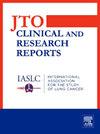Late Immune-Related Adverse Events After At Least Two Years of Immune Checkpoint Inhibitor Therapy: Incidence and Association With Survival in Patients With Advanced NSCLC
IF 3.5
Q2 ONCOLOGY
引用次数: 0
Abstract
Background
Limited data are available on late immune-related adverse events (IRAEs) in patients with metastatic NSCLC receiving immunotherapy (ICI) beyond 2 years.
Methods
A single-institution retrospective analysis including patients who received longer than 2 years of ICI therapy for metastatic NSCLC between 2012 and 2023 was performed. Late IRAEs were defined as those occurring longer than 2 years after initiation of ICI therapy. The association of late IRAE with OS and PFS was assessed using an extended Cox regression with late IRAE modeled as a time-varying covariate.
Results
In a cohort of 76 patients who received longer than 2 years of ICI, the median duration of treatment was 41.9 months, and 44 out of 76 (58%) experienced an early IRAE before 2 years. After 2 years on ICI, 38 out of 76 (50%) of patients experienced a late IRAE, many of whom (39%) had no previous early IRAE. Higher rates of late IRAEs were seen in females (p = 0.032), White patients (p = 0.041), and patients with previous grade 2 or higher IRAE (p = 0.020). Late IRAE occurrence was not associated with median progression-free survival or median overall survival.
Conclusions
In patients receiving extended-duration ICI beyond 2 years, late IRAEs were common and often occurred in patients without previous history of IRAE. These findings support consideration of ICI discontinuation at 2 years.
至少两年免疫检查点抑制剂治疗后晚期免疫相关不良事件:晚期非小细胞肺癌患者的发病率及其与生存率的关系
在接受免疫治疗(ICI)超过2年的转移性非小细胞肺癌患者中,晚期免疫相关不良事件(IRAEs)的数据有限。方法对2012年至2023年间接受ICI治疗超过2年的转移性NSCLC患者进行单机构回顾性分析。晚期IRAEs被定义为在ICI治疗开始后超过2年发生的IRAEs。使用扩展Cox回归评估晚期IRAE与OS和PFS的关联,将晚期IRAE建模为时变协变量。结果在76例接受2年以上ICI的患者中,中位治疗时间为41.9个月,76例患者中有44例(58%)在2年前经历了早期IRAE。在ICI治疗2年后,76例患者中有38例(50%)经历了晚期IRAE,其中许多患者(39%)之前没有早期IRAE。晚期IRAE发生率较高的患者为女性(p = 0.032)、白人患者(p = 0.041)和既往IRAE为2级或以上的患者(p = 0.020)。晚期IRAE的发生与中位无进展生存期或中位总生存期无关。结论在接受2年以上延长疗程ICI的患者中,晚期IRAE较为常见,且多发生在无IRAE病史的患者中。这些发现支持考虑在2年时停用ICI。
本文章由计算机程序翻译,如有差异,请以英文原文为准。
求助全文
约1分钟内获得全文
求助全文
来源期刊

JTO Clinical and Research Reports
Medicine-Oncology
CiteScore
4.20
自引率
0.00%
发文量
145
审稿时长
19 weeks
 求助内容:
求助内容: 应助结果提醒方式:
应助结果提醒方式:


